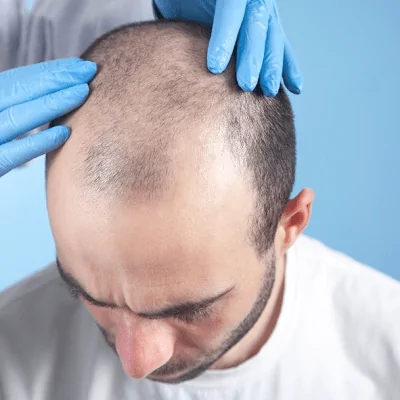What to Expect from a Male Hair Transplant Journey?
Hair transplants have become a popular choice for men experiencing hair loss, offering a permanent solution to restore hair and confidence. However, the journey from consultation to final results is an involved process. Let's Explore Male Hair Transplant in Dubai.
Understanding Hair Loss and Deciding on a Hair Transplant
Before undergoing a hair transplant, it’s essential to understand the cause of hair loss. Male pattern baldness, also known as androgenic alopecia, is one of the most common causes of hair thinning and balding. Consulting with a qualified specialist helps men determine if they are suitable candidates for a transplant. Generally, good candidates have:
- Stable hair loss with sufficient donor hair on the back or sides of the head.
- Realistic expectations about the transplant process and outcomes.
After a thorough consultation, the specialist will help determine the best transplant technique for your needs.
Choosing the Right Technique
There are two primary hair transplant techniques: Follicular Unit Transplantation (FUT) and Follicular Unit Extraction (FUE). Both methods are effective but differ in approach and healing time.
- FUT (Strip Surgery): A strip of skin with hair follicles is removed from the donor area, and individual follicles are then transplanted. This method typically leaves a linear scar, which can be concealed with longer hair.
- FUE: Individual hair follicles are extracted directly from the donor area and transplanted. FUE is less invasive and leaves minimal scarring, making it ideal for men who prefer shorter hairstyles.
Each technique has pros and cons, and your surgeon will recommend the one that best fits your hair loss pattern and lifestyle.
Preparing for the Procedure
Preparing for a hair transplant involves a few essential steps. Your surgeon may recommend avoiding certain medications, alcohol, and smoking, as these can impact blood flow and healing. They might also suggest wearing loose, comfortable clothing on the day of the procedure, as this makes it easier to change without disturbing the treated area afterward.
The Day of Surgery: What to Expect
A hair transplant is typically an outpatient procedure that can last between 4 to 8 hours, depending on the number of grafts needed. Here’s a breakdown of what happens:
- Anesthesia: Local anesthesia is applied to numb the scalp, ensuring minimal discomfort.
- Harvesting Donor Hair: Depending on the technique (FUT or FUE), hair follicles are harvested from the donor area.
- Graft Preparation: Hair follicles are prepared for transplantation while ensuring each graft is intact and healthy.
- Transplantation: Tiny incisions are made in the recipient area, and the surgeon places each graft carefully to ensure a natural look.
While the procedure is painless due to anesthesia, patients may feel some discomfort in the donor and recipient areas afterward.
Immediate Post-Operative Period
After the procedure, expect some swelling, redness, and mild discomfort around the treated area. The surgeon will provide instructions for post-operative care, including:
- Avoiding Touching or Scratching: Touching or scratching the scalp could dislodge the grafts, which are still delicate.
- Sleeping Position: It’s usually recommended to sleep with your head elevated to reduce swelling.
- Medications and Topicals: Your doctor may prescribe medications to manage pain, reduce swelling, and prevent infection.
Most patients can return home the same day, but they should plan for some downtime for the first few days to support the healing process.
Shedding of Transplanted Hair (The Shock Loss Phase)
Around 2 to 3 weeks after the transplant, it’s common for transplanted hair to shed, which can be unsettling. This phase, known as shock loss, is a natural part of the healing process, and the hair will grow back. The follicles are intact beneath the surface, preparing for the new growth cycle.
The Hair Growth Phases
Hair growth following a transplant typically progresses in phases:
- 3 to 4 Months Post-Transplant: New hair begins to emerge, though it may initially be thin and fine.
- 6 to 9 Months Post-Transplant: Hair growth accelerates, and the hair becomes thicker and denser.
- 12 to 18 Months Post-Transplant: Full results are usually visible, with hair blending naturally with existing strands.
It’s important to remember that individual hair growth patterns vary, and patience is key to seeing the final outcome.
Aftercare for Long-Term Success
Aftercare plays a significant role in maintaining the results of a hair transplant. Here are some recommendations for promoting healthy growth:
- Follow Your Doctor’s Advice: Use any prescribed shampoos or topicals as recommended.
- Avoid Harsh Treatments: Limit exposure to chemicals, hot tools, and tight hairstyles that could damage the hair.
- Healthy Lifestyle Choices: Maintaining a balanced diet, staying hydrated, and managing stress contribute to hair health.
Regular follow-ups with the specialist can help monitor progress and address any questions as the hair continues to grow.
Managing Expectations
While a hair transplant can produce significant results, understanding the limitations is essential. The goal is often to achieve a natural-looking improvement rather than complete restoration. Variables like donor hair quality and individual healing processes impact the outcome. Setting realistic expectations with your surgeon will lead to greater satisfaction with the results.
Psychological and Confidence Boost
For many men, the benefits of a hair transplant extend beyond physical appearance. Regaining a fuller head of hair often boosts confidence, enhances self-esteem, and positively affects social and professional interactions. Embracing the changes and allowing time for growth can make the entire experience even more rewarding.
Conclusion
The journey of a male hair transplant involves several stages, from consultation and choosing the right technique to following a meticulous aftercare routine. While it requires patience and commitment, understanding what to expect and staying in close contact with a knowledgeable specialist will help ensure the best possible outcome.



Comments
Post a Comment